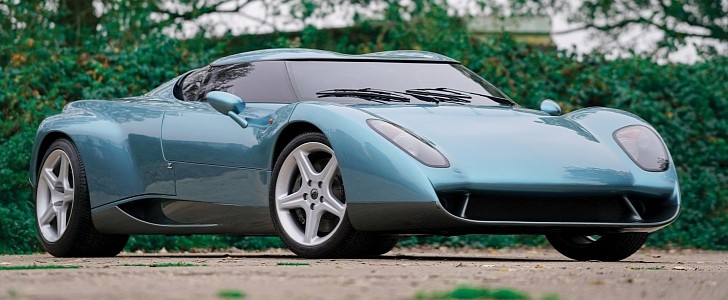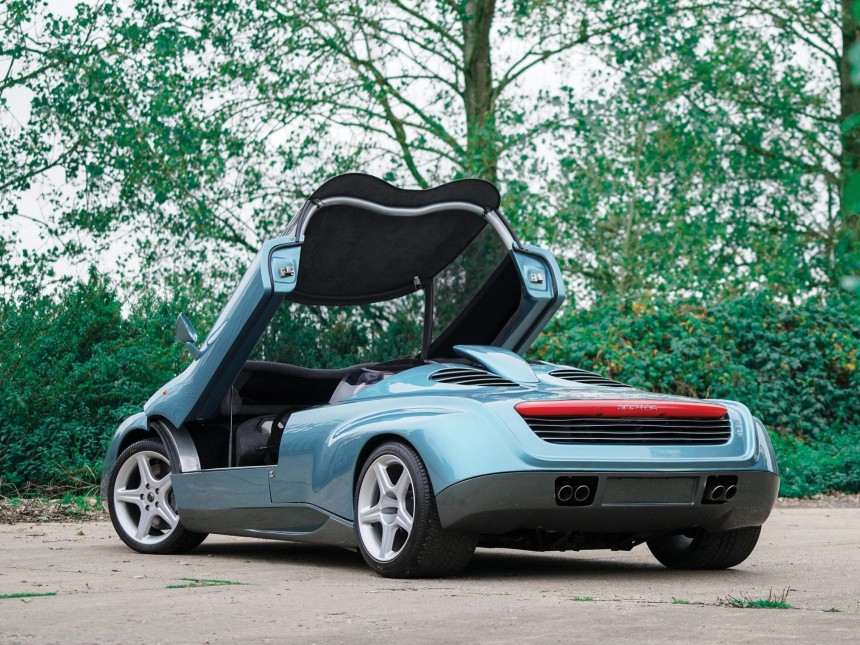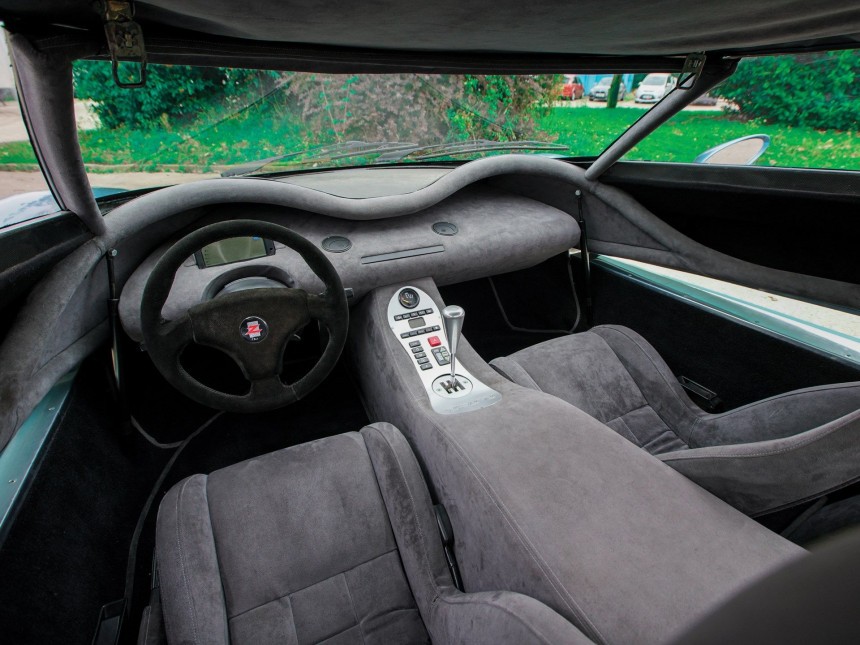Milan-based Zagato and the Raging Bull of Sant’Agata Bolognese first came together in the 1960s with the 3500 GTZ. Only two units were built. Automobili Lamborghini and Carrozzeria Zagato went on different paths after this project, and things would stay this way for three decades.
To understand how the Zagato-bodied Raptor came to be, it’s paramount we talk about Ferruccio Lamborghini’s pride and joy in the 1990s. Codenamed Project 132, the Diablo wouldn’t have come to fruition without Chrysler’s help. The Auburn Hills-based savior purchased the company in 1987, which was then purchased by a Bermuda-registered holding company. Megatech called the shots during this era, giving the green light to the Diablo’s succesor (initially codenamed P147, then L147).
The one and only Marcello Gandini, who ran his own design consultancy firm, was contracted for the car’s exterior styling. Lamborghini wasn’t happy with his proposal, for it was too aggressive for some reason or another. The Diablo-based Acosta concept was followed by the Kanto, which is often spelled Canto in other areas of the web. Penned by Norihiko Harada, chief designer at Zagato, this design study was deemed perfect by the suits in Sant’Agata Bolognese. However, when the Volkswagen Group entered the scene, Ferdinand Piech was not impressed.
Piech appointed Luc Donckerwolke for the Murcielago, which signaled the bitter end of the Giotto Bizzarrini-designed V12 used by Automobili Lamborghini since its very beginning. Turning back time to when Megatech was running the show, the peeps at Zagato penned a wild-looking design study that would have bridged the gap between the Diablo and stillborn Kanto as a limited-run model. Unveiled at the 1996 Geneva Motor Show, four months after it was presented to the higher-ups, the Zagato Raptor wasn’t meant to be. As expected, the cash-stripped Megatech preferred to focus on updating the Diablo until a bonafide successor was ready for production. Alas, one working prototype was finished, bearing chassis number P06.
Born during an extremely tumultuous period for the Italian automaker, the Raptor is rocking a tubular steel spaceframe chassis whose wheelbase is 20 millimeters shorter than a Diablo. Rather than Brembo brake discs and calipers, the Diablo-based Raptor features an Alcon braking system. Gifted with 18-inch magnesium wheels mounted with Pirelli rubber boots, the one-off automotive design marvel is pretty serious in terms of suspension componentry as well, starting with double wishbones on all four corners.
Adjustable dampers from Koni – two up front and four in the rear – also need to be mentioned, along with anti-roll bars that reduce body roll during cornering. Developed using computer-aided design and manufacturing when these technologies were in their infancy, the Raptor’s most radical design element is the roof canopy that lifts up to reveal a simple interior. Curvaceous rear fenders are complemented by horizontal vents and a horizontal cluster of lights. The curvaceous front end features conventional headlights rather than the pop-up units of the Diablo. This design decision was taken with a heavy heart by Zagato – and Lamborghini for the mid-cycle refresh of the Diablo from 1999 - due to revised safety regulations.
Hinged at the front, the canopy integrates a roof panel that can be removed to morph the Raptor from a berlinetta into a targa-like spider. The double-bubble motif that helps Zagato stand out in the crowd is used for the body-color removable panel. Air intake scoops are located on each sill, right before the rear wheels, and a rear deck lid-mounted intake scoop complements the canopy. The rear deck lid vents that flank the aforementioned scoop are meant to cool the Diablo-sourced V12 engine.
Finished in Corfu Blue and Gray, the Raptor is bodied predominantly in carbon fiber. Together with the stripped-out interior, does it come as a surprise that Zagato shed nearly 300 kilograms from the Diablo VT on which this one-off supercar is based? Tipping the scales at 1,350 kilograms (2,976 pounds), the Raptor allegedly exceeds 200 miles per hour (322 kilometers per hour) on full song although it’s never reached that speed.
Zero to 60 miles per hour (97 kilometers per hour) is dispatched in less than four seconds. This incredible acceleration – for that era – was made possible by the Viscous Traction four-wheel-drive system of the Diablo VT. As the name suggests, it employs a viscous coupling that sends up to 25 percent of the naturally-aspirated engine’s resources to the front diff, when needed.
Although it was inspired by the 4WD system in the LM002, the VT is a very different animal for it doesn’t feature a two-speed transfer case that enables high and low ranges, nor does it come with three locking differentials for go-anywhere shenanigans. The four tailpipes out back are connected to the 5.7-liter iteration of the Bizzarrini-developed V12, which pumps out 485 horsepower (492 metric ponies) at 7,000 revolutions per minute and 428 pound-foot (580 Nm) at 5,200 revolutions per minute.
The 60-degree V12 displaces 5,709 cubes thanks to an 87-mm bore and 80-mm strike. Connected to a five-speed manual transmission integrating a single-plate clutch, the free-breathing V12 uses Lamborghini Iniezione Elettronica injection, a dry-sump lubrication system, and three-way cats.
A supercharged option could have made it into production had the Raptor also made it into production, along with a rear-drive variant. With the blower installed, the V12 would’ve pushed over 600 ponies. Other planned extras included alternative exterior colors as well as upholstery choices. Reassuringly uncomplicated, the Raptor’s cabin incorporates an Alcantara three-spoke steering wheel framing a racecar-like monochrome display.
To the right of the non-airbag steering wheel, you’ll find a superb-looking transmission gear lever with an open gate, a few switches, and buttons for the HVAC. Of course, the side windows do not open. Regarding the fate of chassis number P06, the Zagato Raptor last changed hands on the 30th of November in 2019, when it was auctioned in Abu Dhabi for $1,086,250.
The one and only Marcello Gandini, who ran his own design consultancy firm, was contracted for the car’s exterior styling. Lamborghini wasn’t happy with his proposal, for it was too aggressive for some reason or another. The Diablo-based Acosta concept was followed by the Kanto, which is often spelled Canto in other areas of the web. Penned by Norihiko Harada, chief designer at Zagato, this design study was deemed perfect by the suits in Sant’Agata Bolognese. However, when the Volkswagen Group entered the scene, Ferdinand Piech was not impressed.
Piech appointed Luc Donckerwolke for the Murcielago, which signaled the bitter end of the Giotto Bizzarrini-designed V12 used by Automobili Lamborghini since its very beginning. Turning back time to when Megatech was running the show, the peeps at Zagato penned a wild-looking design study that would have bridged the gap between the Diablo and stillborn Kanto as a limited-run model. Unveiled at the 1996 Geneva Motor Show, four months after it was presented to the higher-ups, the Zagato Raptor wasn’t meant to be. As expected, the cash-stripped Megatech preferred to focus on updating the Diablo until a bonafide successor was ready for production. Alas, one working prototype was finished, bearing chassis number P06.
Born during an extremely tumultuous period for the Italian automaker, the Raptor is rocking a tubular steel spaceframe chassis whose wheelbase is 20 millimeters shorter than a Diablo. Rather than Brembo brake discs and calipers, the Diablo-based Raptor features an Alcon braking system. Gifted with 18-inch magnesium wheels mounted with Pirelli rubber boots, the one-off automotive design marvel is pretty serious in terms of suspension componentry as well, starting with double wishbones on all four corners.
Hinged at the front, the canopy integrates a roof panel that can be removed to morph the Raptor from a berlinetta into a targa-like spider. The double-bubble motif that helps Zagato stand out in the crowd is used for the body-color removable panel. Air intake scoops are located on each sill, right before the rear wheels, and a rear deck lid-mounted intake scoop complements the canopy. The rear deck lid vents that flank the aforementioned scoop are meant to cool the Diablo-sourced V12 engine.
Finished in Corfu Blue and Gray, the Raptor is bodied predominantly in carbon fiber. Together with the stripped-out interior, does it come as a surprise that Zagato shed nearly 300 kilograms from the Diablo VT on which this one-off supercar is based? Tipping the scales at 1,350 kilograms (2,976 pounds), the Raptor allegedly exceeds 200 miles per hour (322 kilometers per hour) on full song although it’s never reached that speed.
Zero to 60 miles per hour (97 kilometers per hour) is dispatched in less than four seconds. This incredible acceleration – for that era – was made possible by the Viscous Traction four-wheel-drive system of the Diablo VT. As the name suggests, it employs a viscous coupling that sends up to 25 percent of the naturally-aspirated engine’s resources to the front diff, when needed.
The 60-degree V12 displaces 5,709 cubes thanks to an 87-mm bore and 80-mm strike. Connected to a five-speed manual transmission integrating a single-plate clutch, the free-breathing V12 uses Lamborghini Iniezione Elettronica injection, a dry-sump lubrication system, and three-way cats.
A supercharged option could have made it into production had the Raptor also made it into production, along with a rear-drive variant. With the blower installed, the V12 would’ve pushed over 600 ponies. Other planned extras included alternative exterior colors as well as upholstery choices. Reassuringly uncomplicated, the Raptor’s cabin incorporates an Alcantara three-spoke steering wheel framing a racecar-like monochrome display.
To the right of the non-airbag steering wheel, you’ll find a superb-looking transmission gear lever with an open gate, a few switches, and buttons for the HVAC. Of course, the side windows do not open. Regarding the fate of chassis number P06, the Zagato Raptor last changed hands on the 30th of November in 2019, when it was auctioned in Abu Dhabi for $1,086,250.
























